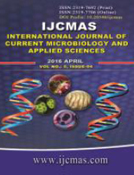


 National Academy of Agricultural Sciences (NAAS)
National Academy of Agricultural Sciences (NAAS)

|
PRINT ISSN : 2319-7692
Online ISSN : 2319-7706 Issues : 12 per year Publisher : Excellent Publishers Email : editorijcmas@gmail.com / submit@ijcmas.com Editor-in-chief: Dr.M.Prakash Index Copernicus ICV 2018: 95.39 NAAS RATING 2020: 5.38 |
Urinary tract infections (UTI) are a serious threat to human health affecting millions of people every year resulting in high morbidity and mortality. Enterobacteriaceae species like Escherichia coli, Proteus mirabilis, Enterobacter aerogenes, Citrobacter freundii and Klebsiella pneumoniae are the commonest uropathogens implicated in bacteremia and nosocomial infections. Aims and objectives: To identify and study the incidence of extended spectrum beta-lactamase producing Enterobacteriaceae in urinary tract infections by different phenotypic detection tests. About 100 Uropathogens isolated from urine samples of inpatients and outpatients of SVMCH during 2014-2015 were included. ESBL producing isolates were identified by screening methods and confirmed by phenotypic methods like DDST, PCT, E-test and CHROM agar. Among 52 isolates of E. coli 40% was ESBL producer, among 4 isolates of Citrobacter 50% was ESBL producer, out of 5 isolates of P. vulgaris 20% was ESBL producer, out of 6 isolates of K. oxytoca 33% was ESBL producer, out of 13 isolates of P. mirabilis 23% was ESBL producer, out of 16 isolates of K. pneumoniae 25% was ESBL producer, out of 3 isolates of E. aerogenes 67% was ESBL producer and none of the isolates of M. morgagnii was ESBL producer. By DDST, 29% of ESBL producing isolates and 71% of non-ESBL isolates were detected. With PCT, E-test and ESBL CHROM agar 35% of ESBL producers and 65% of non-ESBL isolates were detected. Conclusion: For early detection of ESBL producers, methods like DDST, PCT can be performed in microbiology laboratories as routine test, as they are simple to perform and cost effective. Those isolates which are found to be ESBL producers by screening methods can be confirmed by tests like E-test, ESBL CHROM agar which are found to be equally effective in detecting ESBL producers.
 |
 |
 |
 |
 |